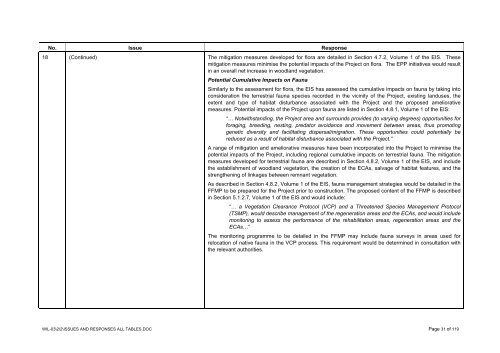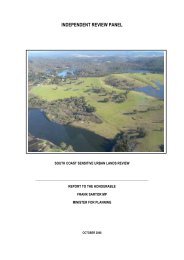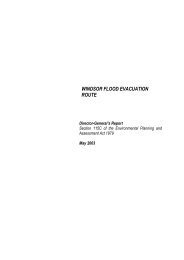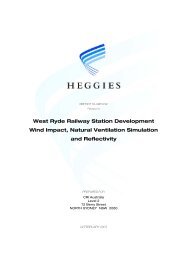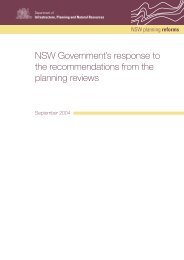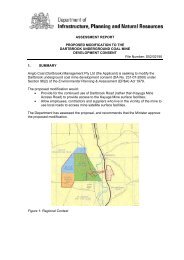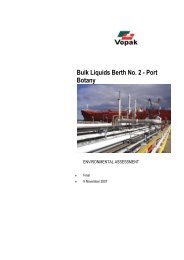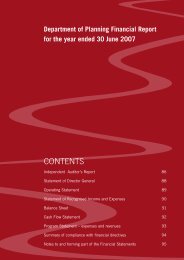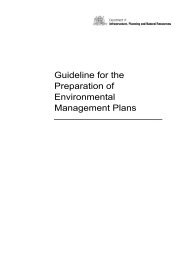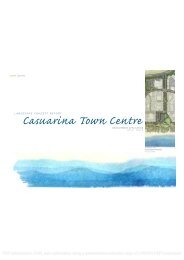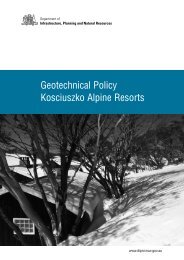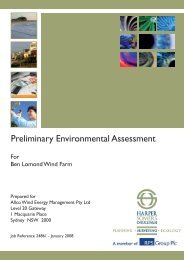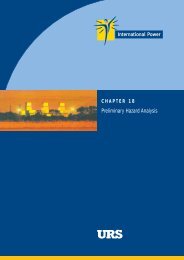wilpinjong coal project wilpinjong coal project - Department of ...
wilpinjong coal project wilpinjong coal project - Department of ...
wilpinjong coal project wilpinjong coal project - Department of ...
Create successful ePaper yourself
Turn your PDF publications into a flip-book with our unique Google optimized e-Paper software.
No. Issue Response<br />
18 (Continued) The mitigation measures developed for flora are detailed in Section 4.7.2, Volume 1 <strong>of</strong> the EIS. These<br />
mitigation measures minimise the potential impacts <strong>of</strong> the Project on flora. The EPP initiatives would result<br />
in an overall net increase in woodland vegetation.<br />
Potential Cumulative Impacts on Fauna<br />
Similarly to the assessment for flora, the EIS has assessed the cumulative impacts on fauna by taking into<br />
consideration the terrestrial fauna species recorded in the vicinity <strong>of</strong> the Project, existing landuses, the<br />
extent and type <strong>of</strong> habitat disturbance associated with the Project and the proposed ameliorative<br />
measures. Potential impacts <strong>of</strong> the Project upon fauna are listed in Section 4.8.1, Volume 1 <strong>of</strong> the EIS:<br />
“… Notwithstanding, the Project area and surrounds provides (to varying degrees) opportunities for<br />
foraging, breeding, nesting, predator avoidance and movement between areas, thus promoting<br />
genetic diversity and facilitating dispersal/migration. These opportunities could potentially be<br />
reduced as a result <strong>of</strong> habitat disturbance associated with the Project.”<br />
A range <strong>of</strong> mitigation and ameliorative measures have been incorporated into the Project to minimise the<br />
potential impacts <strong>of</strong> the Project, including regional cumulative impacts on terrestrial fauna. The mitigation<br />
measures developed for terrestrial fauna are described in Section 4.8.2, Volume 1 <strong>of</strong> the EIS, and include<br />
the establishment <strong>of</strong> woodland vegetation, the creation <strong>of</strong> the ECAs, salvage <strong>of</strong> habitat features, and the<br />
strengthening <strong>of</strong> linkages between remnant vegetation.<br />
As described in Section 4.8.2, Volume 1 <strong>of</strong> the EIS, fauna management strategies would be detailed in the<br />
FFMP to be prepared for the Project prior to construction. The proposed content <strong>of</strong> the FFMP is described<br />
in Section 5.1.2.7, Volume 1 <strong>of</strong> the EIS and would include:<br />
“… a Vegetation Clearance Protocol (VCP) and a Threatened Species Management Protocol<br />
(TSMP), would describe management <strong>of</strong> the regeneration areas and the ECAs, and would include<br />
monitoring to assess the performance <strong>of</strong> the rehabilitation areas, regeneration areas and the<br />
ECAs…”<br />
The monitoring programme to be detailed in the FFMP may include fauna surveys in areas used for<br />
relocation <strong>of</strong> native fauna in the VCP process. This requirement would be determined in consultation with<br />
the relevant authorities.<br />
WIL-03\2\2\ISSUES AND RESPONSES ALL TABLES.DOC Page 31 <strong>of</strong> 119


